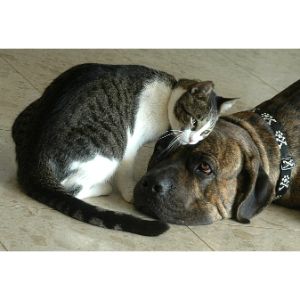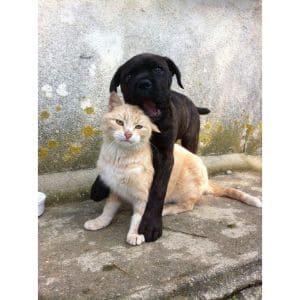Cats and dogs are famous for their antagonistic dynamic. Their long and colorful history of enmity has been playfully depicted in everything from cartoons to Disney films to children’s fiction.
But do all cats and dogs hate each other? And are Cane Corsos good with cats?
This article will explore whether Cane Corsos and cats can amicably cohabit, and exactly how cats and dogs became renowned for their antagonistic relationship.
Other articles you would like: Cane Corso Rottweiler Mix and Facts About The Brindle Cane Corso
Are Cane Corsos Good With Cats?

Perhaps you already have a cat and are considering adopting a dog. Or perhaps, the Cane Corso came first, and you have inherited your grandmother’s beloved feline. Whatever the case, it’s natural to wonder whether Cane Corsos are good with cats.
But to answer this question, we have to start by dissecting the cat-dog relationship.
Why Dogs and Cats Hate Each Other
The fact is, neither cats nor dogs enter the world determined to dislike one another. That famous animosity is the by-product of inter-species miscommunication.
You see this, especially in young animals. Think of news stories where puppies befriend kittens or kittens befriend cows. Animals aren’t naturally conditioned to be aggressive.
Instead, each species has its signals to communicate non-verbally, and they say everything from, “Leave me alone,” to “Come play.”
That’s why you can introduce kittens and puppies to one another and find them cuddled up together hours later. They are both learning to speak their various languages, and they learn to interpret each other along the way.
Where this gets tricky is with older animals.
We’ve all seen a version of this. A cat is asleep in her chair. A puppy comes bounding over to initiate play. She swats at him. In feline, that’s code to leave her alone. But the puppy misconstrues this as a sign she’s playing, too.
So, he keeps pestering, and she keeps swatting. The next thing you know, you have an exasperated cat who disavows all dogs.
They don’t listen; They don’t do what they’re told, and they invade her space. But from the canine perspective, that isn’t what happened at all.
So, are Cane Corsos and cats a good mix?
Cane Corsos and Cats

At the end of the day, Cane Corsos are as good, bad, or indifferent at speaking Feline as any other dog breed.
Several factors determine whether they will be good with your cat:
Age
The first thing to consider is the age of the animals involved. Young cats and dogs make for the most successful inter-species friendships because their brains are still plastic.
They also have limited working experience with other animals, so they are more unbiased than older animals.
That makes it crucial that you take your time introducing your cat to a Cane Corso puppy because one misstep can create traumatic ripples that color your dog’s relationship, not only with the cat in residence but with all cats.
Past Trauma
Another consideration that affects the relationship of your Cane Corso with cats is their prior history with them.
A Cane Corso that was chased, attacked, or otherwise frightened by a cat will be more reluctant to accept a cat into their household than a Cane Corso with no experience with cats.
Dogs retain memories of past trauma, and that’s an important consideration when introducing any dog to a cat because their fear can be misconstrued as aggression by the cat.
Temperament
Another serious consideration when introducing Cane Corsos and cats is temperament.
Cane Corsos make popular guard dogs because their inherent loyalty can manifest as aggression. That’s ideal if you’re being burgled but less than helpful if you are trying to get your Cane Corso and cats to bond.
The Cane Corso isn’t the only animal whose temperament you need to consider in this situation, either. Like dogs and people, cats have unique personalities.
Some, like the Rag Doll, are famously accommodating, while others, like tortoiseshell cats, are infamously opinionated and stand-offish.
To successfully integrate a Cane Corso and cat into the same household, you need a thorough understanding of both animals’ personalities.
What Makes Cane Corsos Good With Cats?

But what makes a Cane Corso good with cats? Without exception, the consideration that makes the most difference is your dog’s socialization.
All dogs benefit from thorough socialization. It teaches them how to:
- Interact with other dogs
- Appropriately approach strangers
- Interact with other animals
- Biting inhibition
This is essential when introducing your Cane Corso to cats because your Cane Corso has an unspoken predatory advantage.
That’s not just because of their temperament, which is naturally more aggressive than other dog breeds, but because they are significantly bigger than the average house cat.
Cats are acutely aware that they are both predators and prey. Conversely, Cane Corsos’ have a high prey drive. So, no matter how careful you are, the cat in this scenario will approach the Cane Corso with wariness.
It’s important to remember that whatever it looks like, that wariness isn’t outright aggression. It’s the cat defining their boundaries. And that’s where thorough canine socialization makes a difference.
A well-socialized Cane Corso won’t necessarily speak fluent Cat. But, they will be better at identifying the boundaries cats try to set.
How To Introduce a Cane Corso and a Cat

With all that in mind, how do you introduce a Cane Corso and a cat?
Train Your Cane Corso
First of all, you need to ensure your Cane Corso is well-trained. There’s no sense introducing them to the cat until they can master commands like ‘Sit,’ ‘Stay,’ and ‘Come Here.’
Create a Safe Space
If you are confident your Cane Corso has training mastered, the next step is to develop a safe place for each animal. This is a space that is off-limits to others. The cat can retreat to their safe place after meeting the Cane Corso and vice-versa.
Ideally, these spaces have operational doors. That’s because it’s not just meeting a cat or dog your new pet finds stressful. It’s everything, up to and including being in a strange environment.
The most effective technique to help new pets acclimatize to their home is to keep them in this safe space for the first two to three weeks.
Their designated area will accrue pheromones quickly, and that keeps them calm when they eventually interact with the other pet.
It also lets you ensure that all interactions between Cane Corso and the cat are supervised.
Arrange a First Meeting
Once all pets have acclimatized to the house, they can meet each other.
Baby gates are useful in this situation. You can keep the cat on one side of the gate and the Cane Corso on the other.
Because cats are natural climbers, it may be helpful to keep the cat harnessed. That prevents them from trying to leap over the gate.
However, you also need to consider your cat’s comfort. Some cats won’t feel safe in a harness. If that sounds like your cat, keep the Cane Corso leashed and allow your cat to move freely. Cats that feel unsafe will retreat to their safe place, away from the dog.
Meeting and Eating
Once your Cane Corso rubs noses with the cat a few times, you can start encouraging them to eat simultaneously.
Keep the baby gate in place and place a favorite treat or food in front of both animals.
Some people recommend this as an immediate second step, but it’s important to realize that neither cats nor dogs will eat if they feel uncomfortable. For cats especially, that means not eating around another animal.
That’s because a cat is at their most vulnerable when eating. Their attention is elsewhere, and they feel exposed to predators.
But you need to create a strong positive association for your Cane Corso with the cat, and mutual feeding is an excellent way to do that.
Face-to-Face Meetings for Cane Corso With Cats
The next step is introducing your Cane Corso to the cat without the baby gate in place.
Always supervise these sessions. If at any point the cat wants to leave, let them. Crucially, you must ensure your Cane Corso won’t chase the departing cat.
That’s why training is imperative. Your Cane Corso must respond to ‘Stay,’ even in the face of a stimulated prey drive. Otherwise, it breeds animosity between them and the anxious cat.
It can also help to keep a blanket handy. If somehow, your cat gets their claws into your Cane Corso successfully, dropping a towel or blanket over the cat will distract them and allow you to remove them from the dog without risk of redirected aggression.
Let Your Cane Corso Interact With the Cat
Finally, when your animals are comfortable around each other, you can let the two animals interact independently.
Only do this when you feel that the cat feels safe around the Cane Corso. You must also be confident the Cane Corso won’t try and chase the cat.
Observe from a safe distance. If you notice signs of stress from either animal, intervene and redirect their focus away from each other.
Sings of a stressed cat include:
Increased vocalization (ie meowing, hissing, growling)
- Bushy tail
- Arched back
- Flattened ears
- Swatting/batting with paws (sheathed or unsheathed)
Cane Corsos convey stress by:
- Barking
- Pacing/circling
- Panting
- Sudden weight shifts
- Dilated pupils
Conclusion For “Are Cane Corsos Good With Cats?”

Are Cane Corsos good with cats? The answer is complicated.
All animals are different, and various complex factors determine whether Cane Corsos are good with cats. If you want to introduce a cat to your Cane Corso, stop to consider:
- Age
- Temperament
- Past traumas
Crucially, if your Cane Corso previously expressed aggression towards a cat or tried to hurt a feline, you should avoid forcing cohabitation.
That said, with time and patience, a well-socialized Cane Corso can develop an amicable relationship with cats. Neither animal comes pre-programmed to be antagonistic, and with a bit of effort, they can become friends.
However, this is achieved most successfully when both animals are young. The later you leave it, the more likely it will be that there is always a certain amount of unspoken stress, especially on the cat’s side of the equation.
That’s not an indictment of Cane Corsos. That’s your cat’s self-preservation instincts coming into effect.
So, as you introduce a Cane Corso and a cat, ensure your Cane Corso is always under control. Let the cat dictate the speed the relationship progresses, and above all else, don’t let the dog chase after them.
You will also like:
- Does A Cane Corso Shed?
- Are Cane Corsos Hypoallergenic?
- Cane Corso In The Snow – Can They Handle Cold Weather?
For more information about the Cane Corso Breed, check out the video below:




